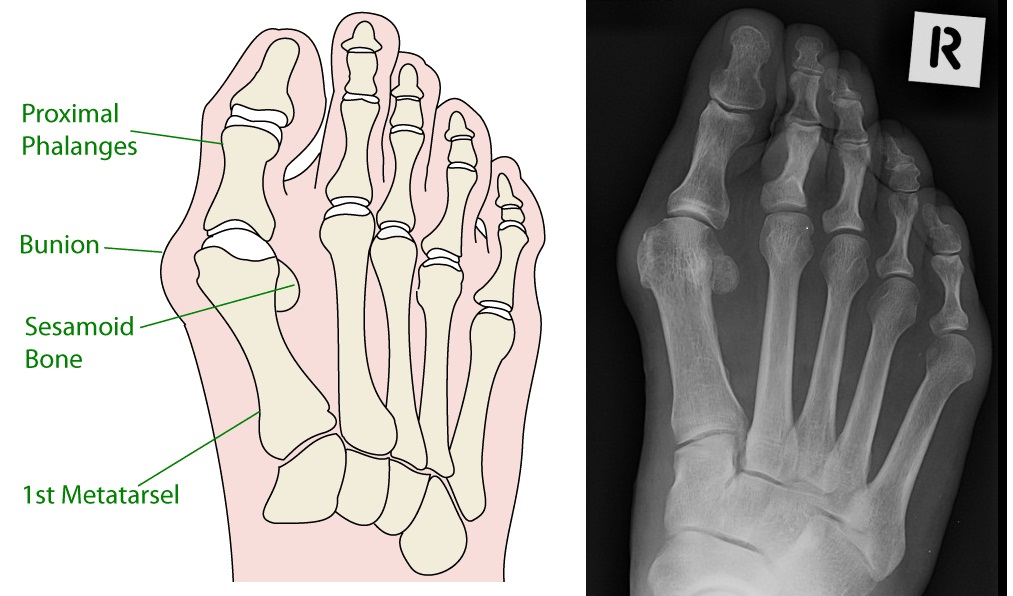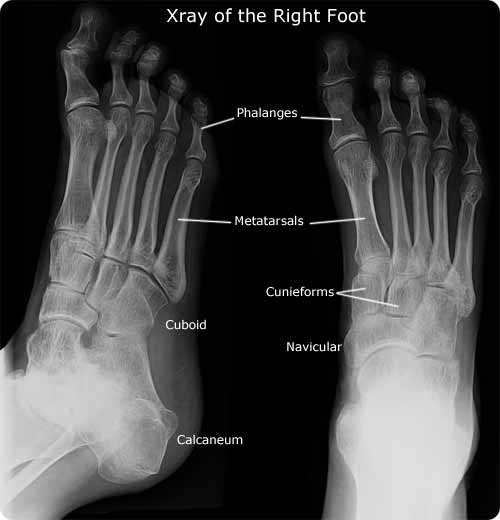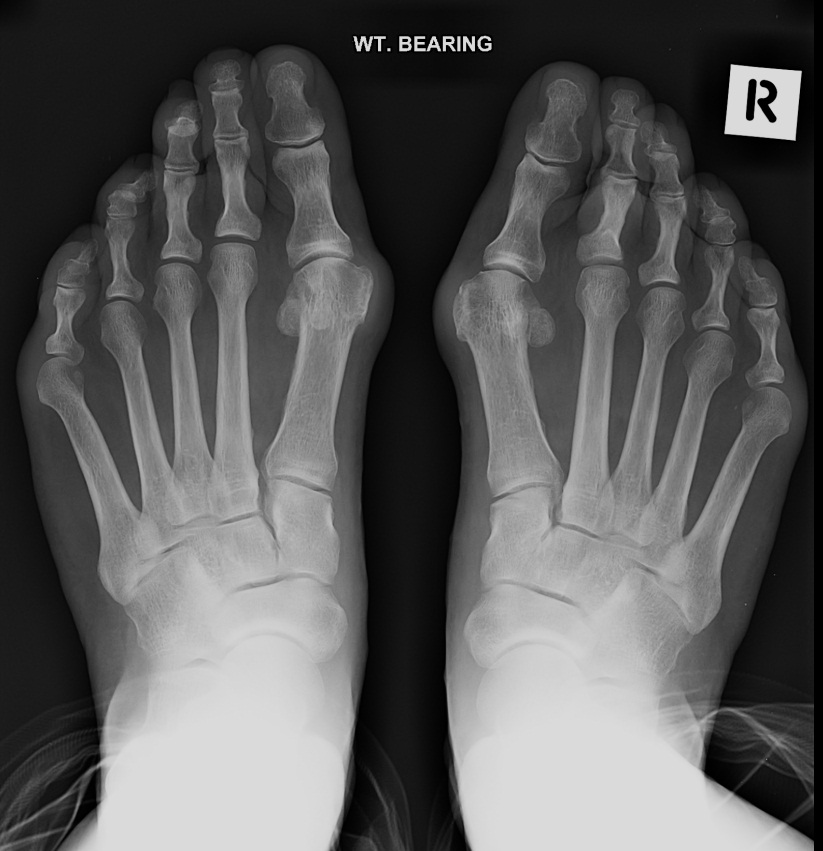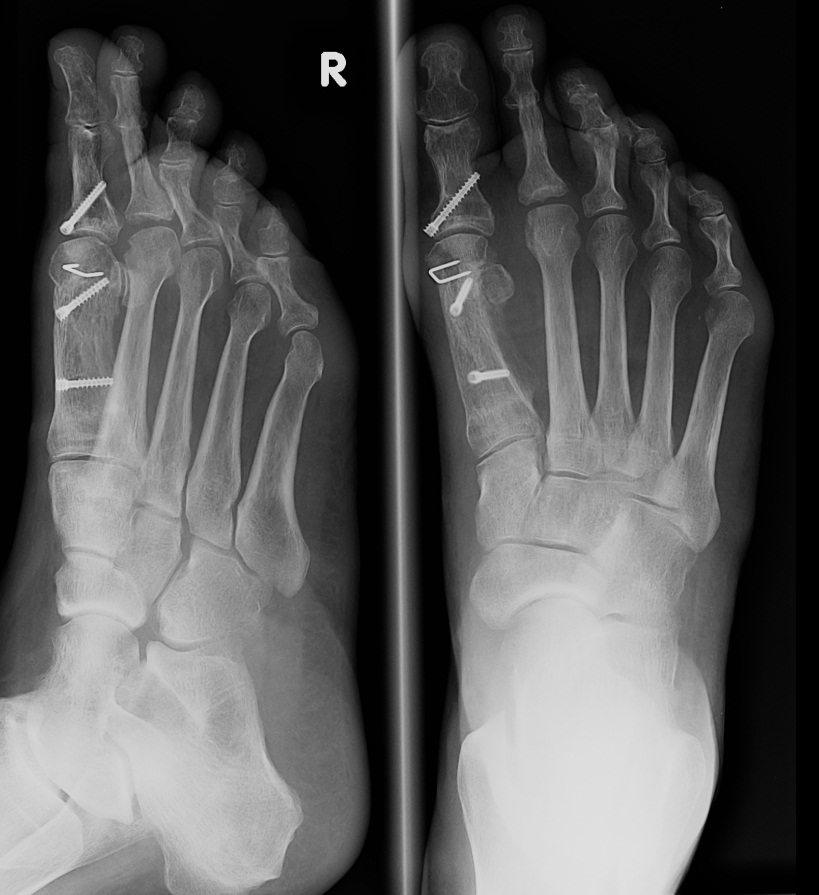A bunion is an abnormal painful, bony bump that forms at the base of the big toe. The bunion is simply the lump on the side of the foot, while the underlying cause of the bunion is a minor deformity called Hallux Valgus. In Hallux Valgus, the bones that make up the large toe are at an angle rather than lying along a straight line.

Diagram of the Foot looking from above.
It shows a bunion as the bump that has formed at the base of the big toe. In addition, ‘hallux valgus’ is visible as the 1st metatarsal points out (away from the other bones), while the phalanx points in, causing first and second toes to touch. The sesamoid bones are also visible – these tiny discs should lie almost directly underneath the metatarsal bone.
Bunions & Hallux Valgus can occur for a number of reasons, but they are often associated with long-term use of inappropriate shoes. Regardless of footwear, there are a number of factors in the basic anatomy of the foot, including flatfeet or slightly loose joints, that make the development more likely.
The pain in the toe or along the bump can often be relieved with wearing correct or modified shoes. When this is inadequate, surgery can help by straightening the bones and removing the bunion. For more information, see Surgery for Hallux Valgus.
Symptoms
Bunions are very common, and present a wide spectrum of issues from difficulty walking through to difficulty buying shoes. In many cases, bunions and hallux valgus cause no problem at all.
The possible signs and symptoms of a bunion include:
- A bulging bump on the outside of the base of your big toe
- Swelling, redness or soreness around your big toe joint
- Thickening of the skin at the base of your big toe
- Corns or calluses — these develop where the first and second toes overlap
- Persistent or intermittent pain
- Restricted movement of your big toe
Pain from a bunion can range from mild to severe, often making it difficult to walk in normal shoes. The skin and deeper tissue around the bunion also may become swollen or inflamed.
The other toes can be affected by a bunion as a result of pressure from the big toe pushing inward toward them. Toenails are more likely to become ingrown, or to irritate the other toes. Sometimes changes in your feet and the way you walk can result in the smaller toes becoming bent or claw-like (hammertoes), in particular the second toe.
When to see your doctor
Although bunions often require no medical treatment, see your doctor or a healthcare professional who specializes in treating foot disorders (podiatrist) if you have:
- Persistent big toe or foot pain
- A visible bump on your big toe joint
- Decreased movement of your big toe or foot
- Difficulty finding shoes that fit properly
Causes
Hallux Valgus occurs when the normal balance of forces acting around the joints and tendons of the feet are disrupted. This eventually leads to joint instability, with the metatarsal gradually sitting at an angle to the foot. The toe is then forced inwards, with a bump (the bunion) forming as the tendons and other tissues around the toe react to the abnormal position.
Interestingly, bunions can also occur on the joint of your little toe (bunionette).
Causes of this abnormal balance of forces resulting in bunions include:
- High-heeled, ill-fitting shoes or those with points (eg ballet)
- Inherited foot type
- Foot injuries
- Conditions that affect the shape of the feet including:
- Deformities present at birth including clubfoot and flatfeet
- Rheumatoid Arthritis
- Diabetes
- Arthritis
Any work or activity that puts extra stress on your feet can also be a cause of bunions.
Risk Factors
These factors may increase your risk of developing bunions:
- High heels. Wearing high heels forces your toes into the front of your shoes, often crowding your toes.
- Ill-fitting shoes. People who wear shoes that are too tight, too narrow or too pointed are also more susceptible.
- Arthritis. Arthritis may increase your risk through pain that changes the way you walk.
- Genetics & Heredity. A family history of bunions may mean you have inherited a tendency to develop bunions, possibly as a result of minor defects in the structure of the foot.
Investigations
Your doctor can identify a bunion simply by examining your foot. During the exam, your doctor will ask you to move your big toe up and down to determine if your range of motion is limited. Your doctor will also look for signs of redness or swelling and asks you about pain.
After examining your foot, taking an X-ray allows your doctor to determine the cause of the bunion and to assess its severity.
Rarely, other tests may be ordered including:
Your doctor will likely ask questions about the types of shoes you wear and how frequently you wear them. He or she may also ask if anyone in your family has had bunions or if you’ve had any injury to your foot.

Above – Xray of the normal Right Foot

This X-Ray shows hallux valgus deformity & bunions in both feet, with a more exaggerated deformity on the right. Note the angle of the metatarsal bone. – it should lie in a line as the other toes do.
Complications
Bunions may develop at any time, and though they don’t always cause problems, they’re permanent unless surgically corrected. If the cushioning sac of fluid (bursa) over the affected joint becomes inflamed (bursitis), a bunion can be very painful and interfere with your normal activities. Bunions do also have a tendency to grow with time, and may get larger and more painful, making soft wide shoes less effective at controlling symptoms.
Other complications can include:
- Skin changes like corns and callouses developing over the bump
- Changes in other toes, including hammertoe or clawing
Treatment
These tips may provide relief from a bunion:
- Apply a non medicated bunion pad around the bony bump.
- If a bunion becomes inflamed or painful, apply an ice pack two to three times daily to help reduce swelling.
- Wear shoes with a wide and deep toe box.
- Avoid shoes with heels higher than 6 centimetres.
See your doctor if pain persists.
Treatment options vary depending on the severity of your bunion and the amount of pain it causes you. Early treatment is best to decrease your risk of developing joint deformities.
Conservative treatment
Nonsurgical treatments that may relieve the pain and pressure of a bunion include:
- Changing shoes. Wear roomy, comfortable shoes that provide plenty of space for your toes.
- Padding and taping. Your doctor can help you tape and pad your foot in a normal position. This can reduce stress on the bunion and alleviate your pain.
- Medications. Paracetamol can control the pain of a bunion. Your doctor may suggest nonsteroidal anti-inflammatory drugs (NSAIDs), such as ibuprofen or for relieving pain and reducing inflammation. Cortisone Steroid injections also can be helpful.
- Shoe inserts. Padded shoe inserts (orthotics) can help control abnormal movement of your foot, reducing your symptoms and preventing your bunion from getting worse. Over-the-counter arch supports can provide relief for some people, though others may require prescription orthotics.
Surgical options
If conservative treatment doesn’t provide relief from your symptoms, you may need surgery. A number of surgical procedures are performed available, and no particular surgery is best for every problem. Knowing what caused your bunion is essential for choosing the best procedure to ensure correction without recurrence. Most surgical procedures include a bunionectomy, which involves:
- Removing the swollen tissue from around your big toe joint
- Straightening your big toe by removing part of the bone
- Realignment of the metatarsal bone to reduce angular deformity
- Permanently joining the bones of your affected joint
It’s possible you may be able to walk on your foot immediately after some bunion procedures, but with others, full recovery can take up to eight weeks or longer. To prevent a recurrence, you’ll need to wear proper shoes after recovery.
Surgery isn’t recommended unless a bunion causes you frequent pain or interferes with your daily activities. A bunionectomy — like other types of surgery — is not without risk. Additionally, you may still have pain or you could develop a new bunion in your big toe joint after surgery. Consider trying conservative treatment before having a bunionectomy.

Seeking Advice
Your Family Doctor (GP)
Your Family Doctor will be able to diagnose and help treat your problem. He or she will be able to
- tell you about your problem
- advise you of the best treatment methods
- prescribe you medications
- and if necessary, refer you to Specialists (Consultants) for further treatment
Your Podiatrist
Prevention
To help prevent bunions, wear comfortable shoes that fit well:
- Be sure your shoes don’t cramp or irritate your toes.
- Choose shoes with a wide toe box — there should be space between the tip of your longest toe and the end of the shoe.
- Your shoes should conform to the shape of your feet without causing undue pressure.
More Information
More information and support services can be found at the following sites:
- Patient information, forums and stories and more:
- Real Time Health – videos and stories from patients
- Virtual Medicine Centre
- MyDr Australia
- Physiotherapy and Rehabilitation
- Physiotherapy Choices – a site offering explanations of the findings in the latest research available
- Centre for Evidence Based Physiotherapy
- Allied Health Evidence
- Healthy Living & Other Useful Sources
Medical sources on First Metatarsal Fusion:
The latest research on first metatarsal joint fusion is accessible through the Cochrane Library and PubMed Database.
References
Robinson, A.H., Limbers, J.P,’Modern Concepts in the Treatment of Hallux Valgus’, Journal of Bone and Joint Surgery Britain, August 2005 vol. 87-B no. 8 1038-1045.
